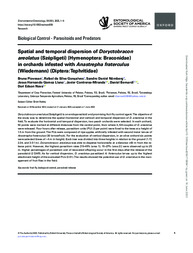Spatial and temporal dispersion of Doryctobracon areolatus (Szépligeti) (Hymenoptera: Braconidae) in orchards infested with Anastrepha fraterculus (Wiedemann) (Diptera: Tephritidae).
Spatial and temporal dispersion of Doryctobracon areolatus (Szépligeti) (Hymenoptera: Braconidae) in orchards infested with Anastrepha fraterculus (Wiedemann) (Diptera: Tephritidae).
Author(s): PIOVESAN, B.; GONÇALVES, R. da S.; NÖRNBERG, S. D.; LLANO, J. H. G.; CONTRERAS-MIRANDA, J.; BERNARDI, D.; NAVA, D. E.
Summary: Doryctobracon areolatus (Szépligeti) is an endoparasitoid and promising fruit fly control agent. The objective of the study was to determine the spatial (horizontal and vertical) and temporal dispersion of D. areolatus in the field. To evaluate the horizontal and temporal dispersion, two peach orchards were selected. In each orchard, 50 points were marked at different distances from the central point, from where 4,100 couples of D. areolatus were released. Four hours after release, parasitism units (PU) (3 per point) were fixed to the trees at a height of 1.5 m from the ground. The PUs were composed of ripe apples artificially infested with second instar larvae of Anastrepha fraterculus (30 larvae/fruit). For the evaluation of vertical dispersion, in an olive orchard six points were selected (trees of ?4 m in height). Each tree was divided into three heights in relation to the ground (1.17, 2.34, and 3.51 m). Doryctobracon areolatus was able to disperse horizontally at a distance >60 m from the release point. However, the highest parasitism rates [15–45% (area 1); 15–27% (area 2)] were observed up to 25 m. Higher percentages of parasitism and of recovered offspring occur in the first days after the release of the parasitoid (2 DAR). As for vertical dispersion, D. areolatus parasitized A. fraterculus larvae up to the highest attachment height of the evaluated PUs (3.51). The results showed the potential use of D. areolatus in the management of fruit flies in the field.
Publication year: 2023
Types of publication: Journal article
Keywords: Doryctobracon areolatus, Mosca das Frutas, Pêssego
Observation
Some of Embrapa's publications are published as ePub files. To read them, use or download one of the following free software options to your computer or mobile device. Android: Google Play Books; IOS: iBooks; Windows and Linux: Calibre.
Access other publications
Access the Agricultural Research Database (BDPA) to consult Embrapa's full library collection and records.
Visit Embrapa Bookstore to purchase books and other publications sold by Embrapa.

